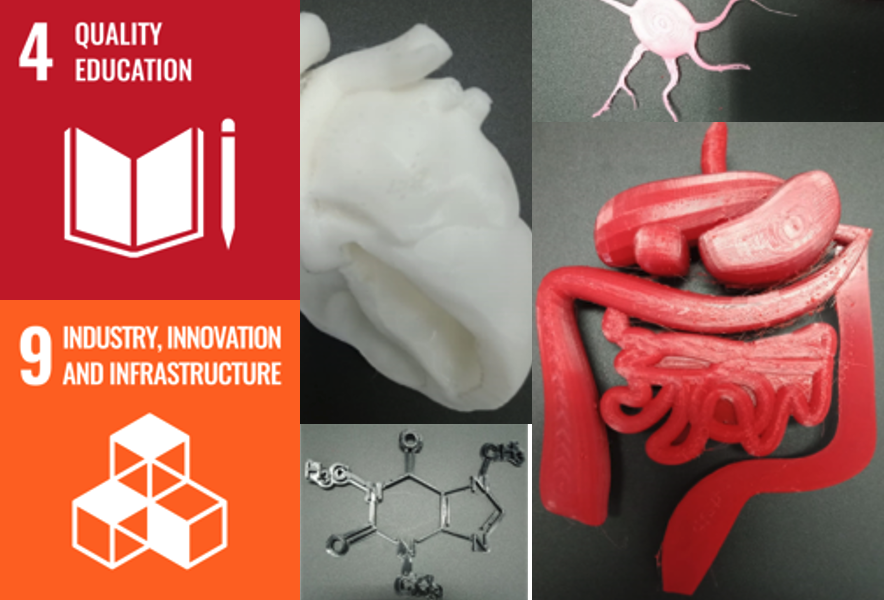Main Article Content
Abstract
Teaching props can help make the learning process more effective by bringing students closer to a concept through a more tangible representation. However, many schools struggle to meet the need for teaching aids, as seen at SMA Sholihin in Bandongan District, Magelang Regency. With advancements in manufacturing technology, an affordable solution is now available to address this issue: 3D printing. The purpose of this community service program is to provide education on the utilization of 3D printing for developing teaching props. The method used involves training on the basic concepts of 3D printing, how to obtain 3D models, and how to operate a 3D printer. The material was delivered through presentations, discussions, and direct demonstrations of the process of creating three-dimensional objects using a 3D printer. At the end of the program, six educational teaching props were successfully produced using 3D printing, along with an improved understanding of the fundamentals of 3D printing technology, 3D modeling, and 3D printer operation.
Keywords
Article Details

This work is licensed under a Creative Commons Attribution-NonCommercial 4.0 International License.
References
- Charoenseang, S., Jailungka, P., & Thammatinno, C. (2020). Web-based Teleoperation System for Learning of 3D Prototype Designing and Printing. In Lecture Notes in Computer Science (pp. 391–407). https://doi.org/10.1007/978-3-030-50506-6_27
- Hartono, K. A. (2021). Changing on How We Learn Anatomy: A Descriptive Study on Using 3D Printed Models for Teaching Atrial Septal Defect. Universitas Gadjah Mada.
- Hidayah, I. (2018). Pembelajaran Matematika Berbantuan Alat Peraga Manipulatif pada Jenjang Pendidikan Dasar dan Gerakan Literasi Sekolah. PRISMA, Prosiding Seminar Nasional Matematika, 1.
- Kania, N. (2018). Alat Peraga untuk Memahami Konsep Pecahan. Jurnal Theorems: The Original Research of Mathematics, 2(2), 1.
- Kasihani, N. N., & Rikawarastuti. (2023). Study of 3D Printing Model in Dental Health Education Preclinic Practices: Narrative Review. JDHT Journal of Dental Hygiene and Therapy, 4(1), 88–96. https://doi.org/10.36082/JDHT.V4I1.1033
- Michalak, D., & Rozmus, M. (2020). Methods and Tools for Acquiring High-Quality Skills in Digital Era - Innovative Practices and Results from 3DSPEC and e-MOTIVE Projects. In Advances in Intelligent Systems and Computing (pp. 260–270). https://doi.org/10.1007/978-3-030-20135-7_26
- Mislan, & Mulyono, S. (2021). Potensi 3D Printing Sebagai Media Edukasi dalam Pendidikan Keperawatan. Jurnal Cakrawala Ilmiah, 1(5), 895–908. https://doi.org/10.53625/jcijurnalcakrawalailmiah.v1i5.1142
- Petersen, E., Kidd, R., & Pearce, J. (2017). Impact of DIY Home Manufacturing with 3D Printing on the Toy and Game Market. Technologies, 5(3), 45. https://doi.org/10.3390/technologies5030045
- Pratama, R. G., & Harta, J. (2021). Development of Inorganic Molecular Shape Model Using 3D Printer to Strengthen Student’s Conceptual Understanding. JTK: Jurnal Tadris Kimiya, 6(2), 144–155.
- Recker, F., Schremmer, T., Berg, C., Schäfer, V. S., Strizek, B., & Jimenez‐Cruz, J. (2024). Advancement of 3D Printing Technology for the Development of A Training Model in US-guided vesicoamniotic shunting for early LUTO therapy. Acta Obstetricia et Gynecologica Scandinavica, 103(8), 1550–1557. https://doi.org/10.1111/aogs.14879
- Solikin, M., Yudianto, A., & Adiyasa, I. W. (2022). The Development of Learning Media of 2Stroke Engine Manufactured by 3D Print for Distance Learning. Jurnal Pendidikan Teknologi Dan Kejuruan, 28(1), 121–129. https://doi.org/10.21831/JPTK.V28I1.47499
- Suliani, M. (2020). Persepsi Siswa Terhadap Penggunaan Alat Peraga dalam Pembelajaran Matematika. SJME: Supremum Journal of Mathematics Education, 4(1), 92–100.
- Sun, B., Xiao, Y., Wang, Z., Yang, Y., Zhao, M., & Chen, H. (2024). Application of 3D Printing in Neurosurgical Medical Teaching and Surgical Training: Bibliometric Analysis and Prospects. Journal of Infrastructure, Policy and Development, 8(8), 6988. https://doi.org/10.24294/jipd.v8i8.6988
- Suwardi, Firmiana, M. E., & Rohayati. (2016). Pengaruh Penggunaan Alat Peraga terhadap Hasil Pembelajaran Matematika pada Anak Usia Dini. Jurnal Alazhar Indonesia Seri Humaniora, 2(4), 297–305. https://doi.org/10.36722/SH.V2I4.177
- Wang, Z., Saija, C., Raison, N., Aydin, A., Xu, Z., Zuo, K., Rhode, K., & Pontiki, A. (2025). Low-Cost Male Urogenital Simulator for Penile Implant Surgery Training: A 3D Printing Approach. 3D Printing in Medicine, 11(1). https://doi.org/10.1186/s41205-024-00248-5

